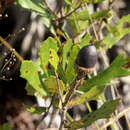en
names in breadcrumbs


Putative hybrid swarms between Quercus minima and Q . chapmanii occur along the eastern side of Florida. These are rhizomatous shrubs with leaves somewhat intermediate between the two parents. The leaves are broadly rounded apically and basally, and sparsely stellate abaxially. The fruit resembles that of Q . minima . Material of such affinity, but with larger nuts (to 25 mm), was the basis for Q . rolfsii Small. More data on variation in cotyledon fusion in the putative hybrid swarms would be useful because Q . minima has connate cotyledons and those of Q . chapmanii are distinct.
Quercus minima has been reported from coastal Texas (C. H. Muller 1970), but that material is probably best referred to Q . fusiformis and possible introgressants from Q . virginiana and Q . oleoides . Typical Q . minima is not known from west of Mississippi. The Texas populations that have been referred here lack leaf dimorphism, leaf shape, and venation of Q . minima . Instead, they seem to be part of an extremely variable complex of erect shrubs, rhizomatous shrubs, and trees that have leaves varying in form between those of Q . fusiformis and Q . oleoides (e.g., the type of Q . oleoides var. quaterna C. H. Muller). If Q . minima occurred on the Texas coast in the past, its presence there has been so diluted by introgression that it is not now recognizable by the very distinctive and reliable characteristics that are used to identify it.
Quercus minima, the dwarf live oak or minimal oak, is a North American species of shrubs in the beech family. It is native to the southeastern United States. It is placed in the southern live oaks section of the genus Quercus (section Virentes).[4]
Quercus minima is an evergreen or semi-evergreen shrub rarely more than 2 metres (6+1⁄2 feet) tall, reproducing by seed and also by means of underground rhizomes. It commonly forms extensive cloned colonies with many stems, many of them unbranched. The leaves are alternate, up to 12 centimetres (4+1⁄2 inches) long, and toothless or with irregular teeth or lobes. The lobes, when present, are usually spine-tipped. The leaves are retained through the winter, dropping just before or as new growth resumes in late winter or early spring.[5]
Quercus minima is native to the coastal plain of the southeastern United States, primarily in Florida but extending from there to the Carolinas and eastern Louisiana.[6] There are reports of the species also growing in Texas, but these populations appear to belong to other taxa.[5][7]
Quercus minima, the dwarf live oak or minimal oak, is a North American species of shrubs in the beech family. It is native to the southeastern United States. It is placed in the southern live oaks section of the genus Quercus (section Virentes).
Quercus minima is an evergreen or semi-evergreen shrub rarely more than 2 metres (6+1⁄2 feet) tall, reproducing by seed and also by means of underground rhizomes. It commonly forms extensive cloned colonies with many stems, many of them unbranched. The leaves are alternate, up to 12 centimetres (4+1⁄2 inches) long, and toothless or with irregular teeth or lobes. The lobes, when present, are usually spine-tipped. The leaves are retained through the winter, dropping just before or as new growth resumes in late winter or early spring.
Quercus minima is native to the coastal plain of the southeastern United States, primarily in Florida but extending from there to the Carolinas and eastern Louisiana. There are reports of the species also growing in Texas, but these populations appear to belong to other taxa.
 Quercus minima leaves
Quercus minima leaves